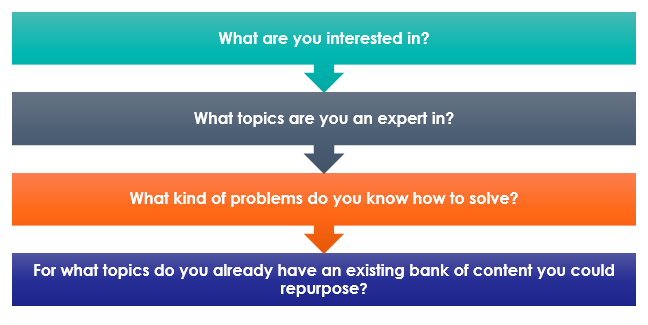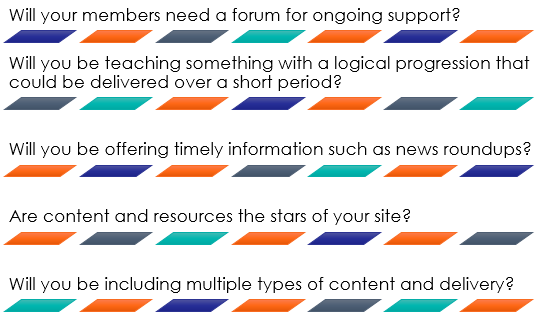Module One
Choose Your Profitable Membership Site Niche / Topic
In this module, you’ll inventory your own interests and knowledge, and research your target market so that you can find a solution-based topic your audience would pay good money for. You’ll choose which membership site model best suits your topic and craft your site’s Unique Value Proposition. Finally, you’ll choose your membership site’s name.
Choosing Your Site’s Topics
Start by brainstorming possible topic ideas. If you’re already considering creating a membership site, there’s a good chance you have a topic in mind. If not, consider the following:

- What are you interested in? What’s your passion?
- What topics are you an expert in? What’s your experience?
- What kind of problems do you know how to solve?
- For what topics do you already have an existing bank of content you could repurpose and use again?
The first step in selecting your topic is to define your target audience for your membership. You need to have a good grasp of exactly who your ideal member is. For an existing business, your best results for quick sales is to target your existing customer base.
If you haven’t already done so, create a target member profile that includes demographics, the main challenges and problems your market faces, and behavioral information. Create this profile as the persona of a single individual (or a few individuals if your market is segmented).
Next, research the topics your target membership is already buying. Look at bestsellers on ClickBank, best-selling books on Amazon, bestsellers on JVZoo, and other top sellers at other marketplaces.
Survey your current customers to see what solutions they’re looking for that are related to your possible topics. You can set up a survey with a tool like Survey Monkey or send out an email, if you have a list. If you have your own online communities, start a dialogue there.
At the same time, conduct market research online, starting with keyword research. Find out what your target market is searching for in search engines by typing in words and phrases related to your topics and seeing the suggested searches. Then use a tool like Google’s Keyword Planner to look at competition and number of searches.
In addition, see what questions come up regularly on social media groups such as Facebook groups or LinkedIn groups, or in online communities like Quora or internet forums. What problems are people trying to solve?
Finally, it’s also essential to research your competitors. How much competition is there and what are they selling? You can use your competition to get ideas, but also for ideas on how to differentiate your membership site from others.
Create a shortlist of two or three ideas. Try to make them as specific as possible, rather than broad topic areas. As you brainstorm and come up with ideas, keep notes of related ideas or subtopics that could be used for content for your site.
Look over your list and judge your ideas according to the following three criteria:

- From your research, which problems have the strongest need for solutions? These are the problems that people will be most likely to pay a membership fee in order to solve.
- Choose a topic that solves a specific problem.
- Choose a topic area where you have the most expertise and knowledge. It should be a topic where you can create high-quality content easily.
Choosing a Membership Model
Refer back to the previous module and review the different types of membership sites out there. As the module stated, certain site models work better for certain topics or audiences. Here are some things to consider when choosing your site model.
Fixed-Term Membership Sites
The topics that work best for a fixed-term site are those with a limited amount of information you want to share. The site might be teaching members how to perform a specific task. It could be a course that’s framed as a membership site. For this type of site, you want people to commit to completing the content in a set period of time to get the best results. For example, it might be a step-by-step guide to setting up your first blog, a week-by-week weight loss program aimed at an event such as a wedding, and so on.
Buffet-Style Membership Sites
These sites work best for topics in which the subscriber wants to access all information all at once, such as a trove of shared resources and knowledge. This is an ideal model for when there’s no set course to follow and the topic is not time-bound. It’s also a good model for topics where subscribers have different levels of expertise or knowledge. Examples would be marketing resources for small businesses, learning to play a musical instrument, or ideas for living in a more environmentally-conscious way.
Drip-Feed Membership Sites
Drip-feed sites are best for information that’s timely or time-sensitive. In this model, you’re giving the subscriber the latest news on a particular topic. It could be something like a weekly challenge or roundup. This type of site also works well for a topic that has steps, where you want the subscriber to receive content in a specific order.
Hybrid Membership Sites
Hybrid membership sites work best for topics where there are multiple types of content people need to have to be successful. This might be a topic for which you set up an online course or coaching service, along with resources and timely information. An example might be a self-help site where subscribers get news, have access to an online resource, and also receive regular coaching calls.
Other Membership Site Models
There are a few other membership site models you might consider.
Online Community. The online community model is a site where the subscriber gets access to communicate with other subscribers. It’s based around an online community where subscribers gain access to private forums, online groups, and private messaging. These are based around a specific topic and they need to be so valuable that people will stay and interact with others.
Product or Service. Another model is the product or service model. This is a membership site that basically exists to deliver a product or service. The site offers a protected download, along with resources, tutorials, follow-up, and customer service help for those who bought the product. The service model follows the same concept, except for a service rather than a product.
To summarize, here is what you should ask yourself to determine which of the above models suits your topic and market best:

- Will your members need a forum for ongoing support? If so, you should choose a community site with recurring monthly payments.
- Will you be teaching something with a logical progression that could be delivered in a matter of weeks? If so, you should choose a fixed-term or drip-feed model.
- Will you be offering timely information such as news roundups? If so, the drip-feed model might be best.
- Are content and resources the stars of your site? If this is the case, you might consider the all-in model.
- Will you be including multiple types of content and delivery? If so, a hybrid model is best.
Crafting Your Unique Value Proposition
In order for your membership site to stand out among your competitors and entice people to join, you need to create a Unique Value Proposition (UVP). This is a statement that explains what your membership site offers, how it solves your customer’s needs, and what distinguishes it from others.
If you think it sounds like a great deal of work to pack this all into a single statement, you’re correct. This is why businesses spend a great deal of time and effort creating their UVP. However, if you do it well, having a good UVP will make it far easier to sell access to your membership site. When you’re clear about how you stand out and the value you offer, it’s easy to explain it to potential members.
The process of creating a UVP involves brainstorming a list of ideas and then narrowing it down to the best one. Here are some tips on creating your UVP:

What Are Your Qualifications?
What qualifications or experience do you have that makes you stand out? Consider academic qualifications, books you’ve written, articles you’ve published in leading magazines or newspapers, awards you’ve won, and so on.
What Do People Say About You?
It’s often hard to discern your unique strengths on your own, so consider what people say about you. Look at testimonials or reviews. What have influencers in your industry said about you? What do people praise you for? What problems have you solved for them? What results have you achieved?
How Do You Compare to the Competition?
Research your competitors. What do they offer and how is what you offer different? What do you do that’s unique and of special value to your audience? Consider how you compare in terms of things like price, quality, speed of delivery or service, breadth of services offered, and so on.
Are You the First to Offer a Membership Site?
If so, consider the types of barriers your competitors will face when they start following your lead. Find something unique you can offer.
To write your UVP, create one short, concise statement that sums up the unique strengths you’ve discovered through brainstorming. What is the benefit your market needs the most and what makes you unique in the way you offer it?
Some Examples of Great UVPs Include:
“We are the largest beauty retailer that provides one-stop shopping for prestige, mass and salon products and salon services in the United States. We focus on providing affordable indulgence to our guests by combining unmatched product breadth, value and convenience with the distinctive environment and experience of a specialty retailer.” – Ulta
“Elegantly simple email marketing. Campaign Monitor makes it radically easy to create, send and measure the impact of your email marketing campaigns.” – Campaign Monitor
Naming Your Membership Site
Choosing a name for your membership site is a crucial decision. It’s not something to be done lightly since it will show up on all your marketing materials, and it’s the first thing people see when they come across your sales page.
Again, the best approach is to brainstorm and narrow down, keeping in mind the following considerations:

- What kind of customers are you trying to attract? Are they men or women? Professionals or hobbyists? Identify their demographics and choose a name that speaks to them.
- What’s the nature of your topic? Is it humorous and light-hearted? Is it serious or business-like? Is it spiritual or uplifting? The name should reflect this.
- Consider SEO. You’ll optimize your content for specific keywords, but it helps if you can skillfully include them in your name.
- Make it memorable. A good way to come up with a memorable name is to choose something funny or hooky, or something with alliteration, rhyme, or onomatopoeia. Avoid using a word or phrase that people might find obscure.
- Use your company name. If you already have a business running, it might be a good idea to incorporate your name or make it similar. This lets your customers know that it’s your site and helps with branding.
- Research the name to make sure it isn’t being used somewhere else already.
Activity:
- Brainstorm ideas for possible topics.
- What topics really interest you?
- What topics are you an expert in?
- What problems do you know how to solve?
- What topics do you have an existing bank of content on?
- Use the Target Member Profile worksheet to create a description of your ideal member for your site.
- Choose your research methods, conduct your research, and note your results.
- Based on your research, create a shortlist of the topics/problems for which your target market has the strongest need for solutions.
- Choose your solution-focused topic for your membership site. Keep a note of your other shortlisted topics to come back to later.
- Decide which membership model you will use. Choose the model that best suits your market’s needs and your topic.
- Craft your site’s Unique Value Proposition.
- Brainstorm and pick a name for your new membership site. Keep the title short and add a tag line for more detail.
A Word
From Tamara
As an entrepreneur myself I completely understand the stress, anxiety and frustration around launching or growing a business. I also know the rewards and life style change the hard work can provide you if you stay focused. I am here to inspire and motivate you to push forward. The fact that you’re investing in your business education let’s me know you’re in this to win. Rest assured I’m here to help you…. These courses are set up to help you understand the basics. To dig deeper into your specific plan of action we will discuss where you are, where you want to be, eliminate any blocks preventing you from getting to the next step and create an action plan.



